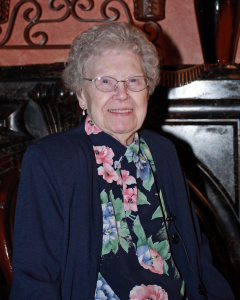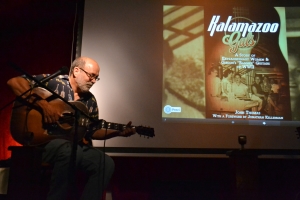 “This guitar was built in 1943. A soldier took it to the European front” (“Denna gitarr byggdes 1943. En soldat tog det till den Europeiska fronten.”)
“This guitar was built in 1943. A soldier took it to the European front” (“Denna gitarr byggdes 1943. En soldat tog det till den Europeiska fronten.”)
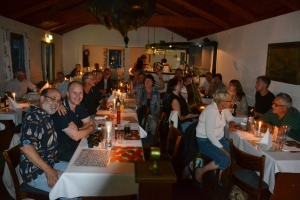 I’m standing on stage in front of a packed club in Kalmar, Sweden holding a 1943 “Banner” Gibson Southerner Jumbo and beginning to tell the tale of my five year journey that produced Kalamazoo Gals. The audience is rapt and to a person leaning forward as if to catch every word and, when I pick a song, every note. I’m astonished to see the Gals’ story resonate with folks a continent and 5,000 miles away. Maybe I shouldn’t be. The story’s themes – hardship, patriotism, music, prejudice, and triumph – are universal topics of the human endeavor. Still, it’s thrilling to see Kalamazoo Gals embraced in a distant land.
I’m standing on stage in front of a packed club in Kalmar, Sweden holding a 1943 “Banner” Gibson Southerner Jumbo and beginning to tell the tale of my five year journey that produced Kalamazoo Gals. The audience is rapt and to a person leaning forward as if to catch every word and, when I pick a song, every note. I’m astonished to see the Gals’ story resonate with folks a continent and 5,000 miles away. Maybe I shouldn’t be. The story’s themes – hardship, patriotism, music, prejudice, and triumph – are universal topics of the human endeavor. Still, it’s thrilling to see Kalamazoo Gals embraced in a distant land.
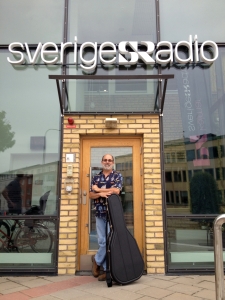 “Embraced” really is the right word for how Gals was received in Kalmar. My friend Lars Lindblom suggested the journey to me and made the arrangements with the hosting club, Stensö. The community jumped on the event with both feet. My daughter and I arrived the day before the gig and stepped off the train in Kalmar to find that the morning newspaper, Barometern (Barometer), had run a very nice story about my appearance, complete with a large photo of me surrounded by guitars.
“Embraced” really is the right word for how Gals was received in Kalmar. My friend Lars Lindblom suggested the journey to me and made the arrangements with the hosting club, Stensö. The community jumped on the event with both feet. My daughter and I arrived the day before the gig and stepped off the train in Kalmar to find that the morning newspaper, Barometern (Barometer), had run a very nice story about my appearance, complete with a large photo of me surrounded by guitars.
Apparently tipped off by the newspaper, Sverigesradio (Radio Sweden) soon emailed requesting a live appearance the studio. I soon found myself, battered 1943 guitar in hand, sitting before two lively interviewers answering questions posed in English and having the interviewers translate both the question and answer for listeners. I played a song, got the thumbs up, signed some books, and made way for the next set of interviewees, a world music group playing original songs on bouzouki (an Irish mandolin), kora (a West African harp-lute), and guitar.
We need Swedish-style radio in the States!
Then came the visit’s high point: the evening gig at Stensö, a rustic almost barn-like structure that hosts concerts and, on nights like the Kalamazoo Gals night, “story telling.” Yes, there is a popular music club that reserves calendar space for artists who simply tell stories about popular culture, history, and, well, anything interesting. In addition, Stensö offers a great BBQ buffet. Really! Prior to hearing touring musicians and the occasional wayward story teller bearing an old, battered guitar, you get a little bit of Austin, Texas in a lovely village in the south of Sweden.
We need Stensö-style clubs in the States!
I was pleased to know, as the club co-owner Lukas Karlsson explained in the Barometern story, I 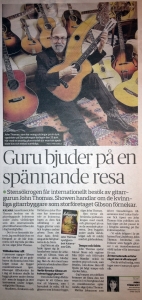 was Stensö’s first “international” performer and something of a club “experiment.” As My friend Lars later expressed to me, the experiment seems to have been a success:
was Stensö’s first “international” performer and something of a club “experiment.” As My friend Lars later expressed to me, the experiment seems to have been a success:
I would like to share a pretty funny anecdote from the night. To my estimate the audience consisted of about one third guitar geeks, one third guitar players, and one third general public. Mattias [Johansson], who is one of the co-owners of the venue and a self-confessed member of the last audience category had this to say when John (with a perfect blend of humor and seriousness) got totally immersed in one Banner guitar x-ray after another: “This is simply beyond geekiness; it is now pure entertainment and I want more.” The statement was of course all tongue-in-cheek, but also very telling of the response John got from the “non-guitar crowd.”
I can’t take full credit for the response that night because I’ve got the greatest of partners on this wild Kalamazoo Gals road show: my 1943 Gibson SJ. I’m the second owner. The first, a soldier, bought the instrument in 1943 and took it to the European battle front. Both guitar and soldier returned from the war battered and bruised but both more beautiful for the experience. I begin each stop on the tour by holding up the guitar, explaining its history, and urging players and non-players alike to hold the instrument because it’s more than a mere inanimate object; touching the guitar really tells the whole Gals’ story. Built by an untrained workforce, the guitar’s obvious imperfections, like offset bracing, actually enhance its musicality. It’s the perfect repository of WWII cultural history.
And hold the SJ and play it the Stensö audience did. Notes from that beautiful, battered instrument rang into the wee hours as I placed it in the hands of each audience member and those two thirds who played guitar each took the stage.
The Kalamazoo Gals are smiling.
Thank you Lars, Stensö, and Kalmar. I hope to return some day.

